How to Get Rid of Fleas in Your Carpet For Good
Looking to get rid of fleas from your carpet for good? We walk through the best ways to do that, and explain how they got there to begin with.

Fleas may be a common household pest, but when you have them, the urge to move might be strong. They multiply quickly, drive your pets crazy, and invite other household pests looking for food sources. They carry disease and make your life difficult all around. It’s not uncommon for them to burrow into your carpet. If you are trying to remove them, there’s 8 simple steps you can take when getting rid of fleas in your carpet for good.
Fleas don’t live long without a host. Typically they move from one place to another, looking for the next victim to bite. So the good news is, if you have fleas in your carpet, or on your shoes and clothing, they won’t usually survive longer than 24 hours without an actual host.
Before you lose hope, there are reliable ways to rid your home of fleas for good. Let’s take a look at the flea life cycle, some natural methods you can try, and some reliable full-nuclear products with chemicals that will rid even the worst flea infestation. Here’s everything you need to know on how to remove fleas from the carpet and your home.
Why Do I Have Fleas?
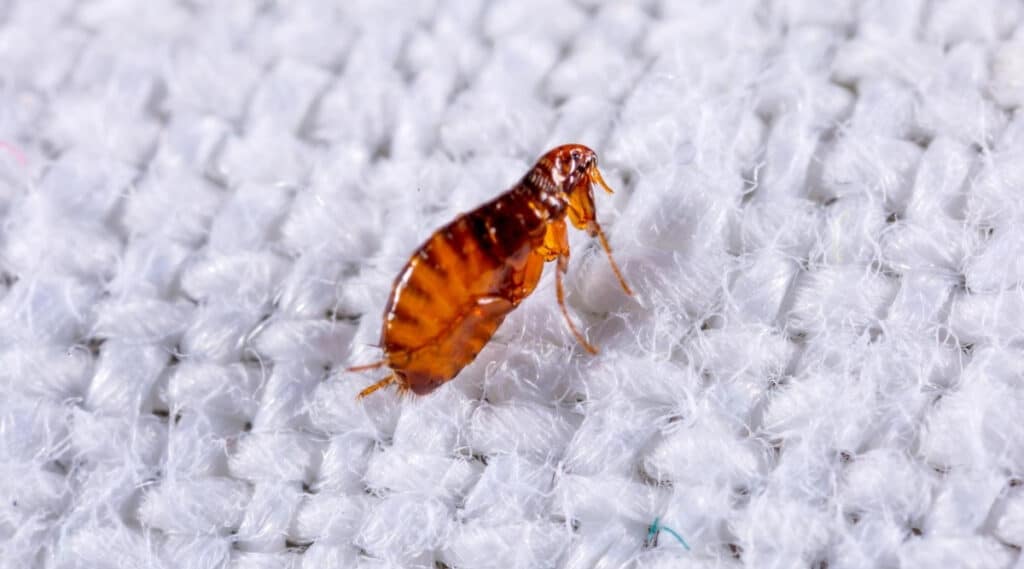
Fleas aren’t just a pet issue, although pets are one of the most common ways fleas infest a home. Fleas come inside as riders on people plus all sorts of animals, including other common household pests like rodents.
Fleas travel, so if your neighbor has a flea-infested yard due to animals, it’s highly likely that your yard will also become infested. If your yard is home to lots of wildlife, the chances of having fleas in your yard are higher.
These fleas come inside and find your pet the perfect food source and your home a comfortable environment to breed. If you have no pets, they could be attracted to other pests you may have.
Fleas aren’t always a sign of a dirty home, and even if your pet receives regular flea treatments, it’s still possible for you to end up with a minor flea problem. Fortunately, there are some solutions to help get rid of them.
How Do I Know I Have Fleas?
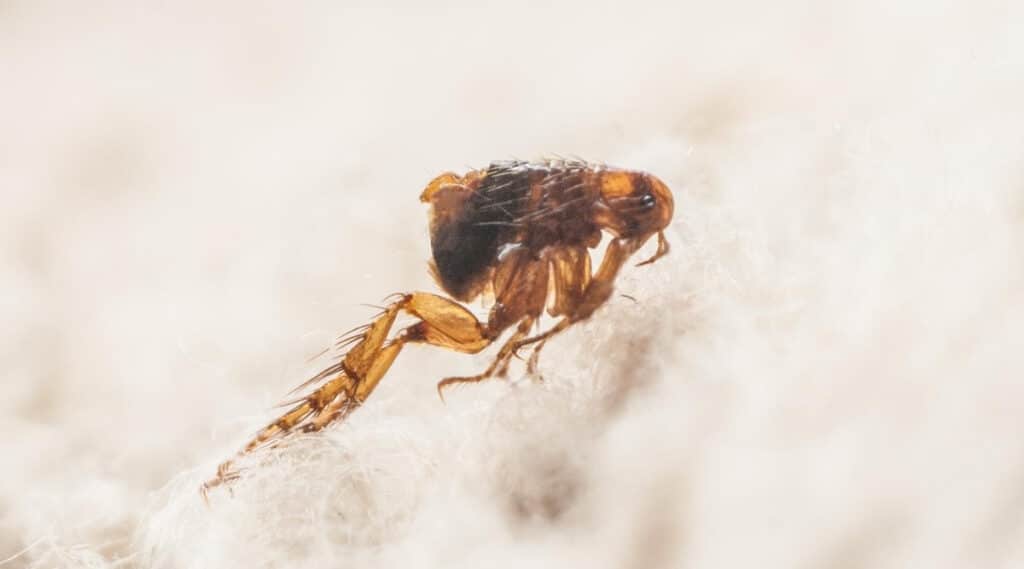
Fleas may not be quite as apparent on carpet as other types of flooring because even the adults are very small. They use the fibers of the carpet to hide, jumping on and off unsuspecting hosts as they move through the house.
In severe infestations, you can wear light-colored socks and stand on your carpet. You’ll be able to see fleas attracted to your warmth easily. In minor infestations, you may not notice much movement.
You’ll notice fleas on your pets, however, who are the favorite food source of these pests. Light-colored animals will show evidence of flea movements, but use a flashlight to examine darker fur. Look around the tail and the abdomen, but keep in mind that fleas could lodge anywhere.
Fleas don’t have much effect on humans, but in the absence of another readily available food source, they may begin biting you. Look for signs of mysterious bites and welts that itch, especially on children who spend more time on the floor.
You can also look with a flashlight at the corners of your home, in between carpet fibers, and in the crevices of your furniture. Fleas, like any insect, prefer to hide, so check out these hidden spots.
Why Should I Care About Fleas?
Fleas are a huge vector for disease, transmitting to your pets and potentially to you if they get hungry enough to bite. They reproduce quickly and can overtake your home in no time without appropriate treatment.
If you catch fleas early enough, you may be able to get rid of them using natural methods that don’t require chemical sprays or professional intervention. Keep in mind, however, that depending on the severity, you may need to treat your home using professional help if both your yard and your carpet are full of fleas.
Step One: Treat Your Pets

The biggest thing you can do to start is to treat a flea’s most common food source — your cats and dogs. If your dogs spend any time outside, even just a half-hour to use the bathroom, you have the chance of bringing fleas into your home if they’re already in your yard. There are a few different types of flea treatments:
Topical: Usually applied topical treatments are applied once per month. Typically applied once a month, these treatments kill existing fleas at all life cycle stages and continue to protect for up to 30 days in most cases.
Oral: Prescription flea medications taken orally also protect against the entire life cycle of the flea for a certain period, depending on the type.
Over The Counter Oral: These options usually provide quick relief from adult fleas that are currently biting but won’t kill eggs or larvae.
Flea Collars: These contain insecticides that kill adult fleas that manage to jump onto your pet, but they may not cover all life cycle stages.
Flea Washes, Sprays, and Shampoos: These treatments can kill adult fleas and often include protection against other life cycles. They don’t provide long-lasting protection and must be repeated as often as needed.
You should also wash your pet’s bedding in hot water and dry on high heat as well as clean out any carriers and soft toys your pet may have. These spaces are hotbeds for flea activity than can transfer quickly to your carpet.
Step Two: Check For Pests
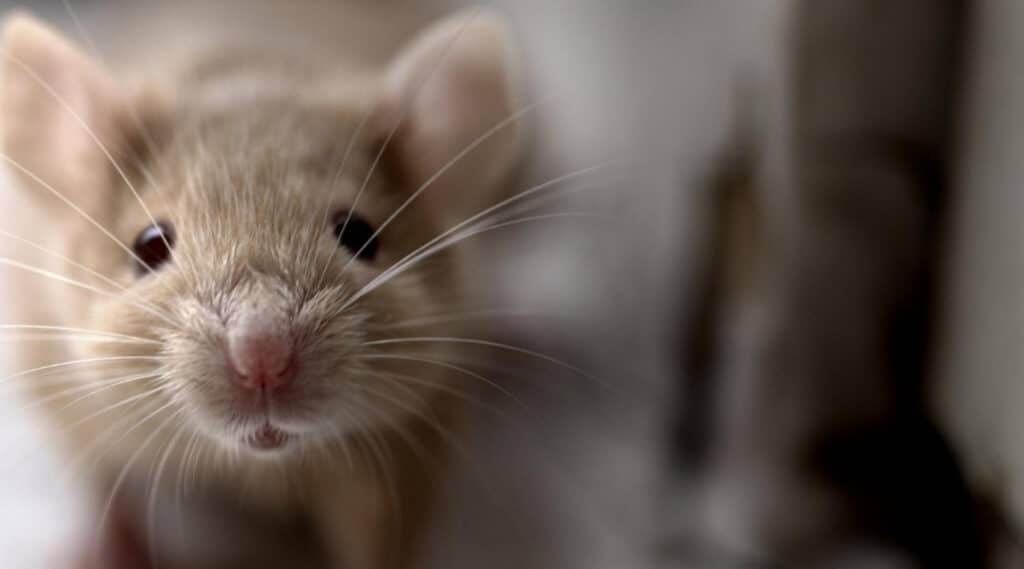
The next piece of this puzzle, or the first if you have no pets, is to have your home inspected for signs of rodent infestations. Even one or two rodents getting into the house is enough to bring in fleas.
An inspector can check for common entry points and help you block them. This could include sealing holes in the foundation or walls, treating crawlspaces and attics, and even cutting back brush from near the home.
Deterring other pests from being able to enter your house, or simply animals like birds looking for temporary nesting spots, can reduce the chances fleas are catching ride indoors and staying.
Step Three: Treat Your Yard
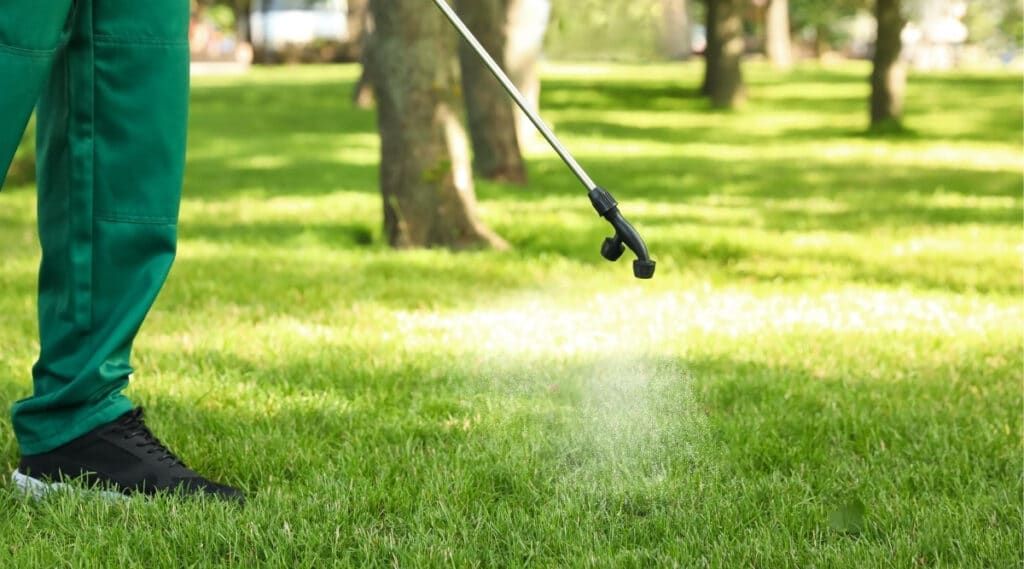
Addressing flea infestations in your yard can help if you don’t have pets and there are no signs of rodents. Even if you do have those first two conditions, lowering the number of fleas in your yard goes a long way to reducing them in your carpet.
There are a number of outdoor flea treatments you can use, both natural and otherwise. Talk with your local exterminator about steps you can take to treat and protect your yard, especially if you live in areas with animals nearby (like farms) or if there is a lot of local wildlife.
Getting Rid Of Fleas in Your Carpet
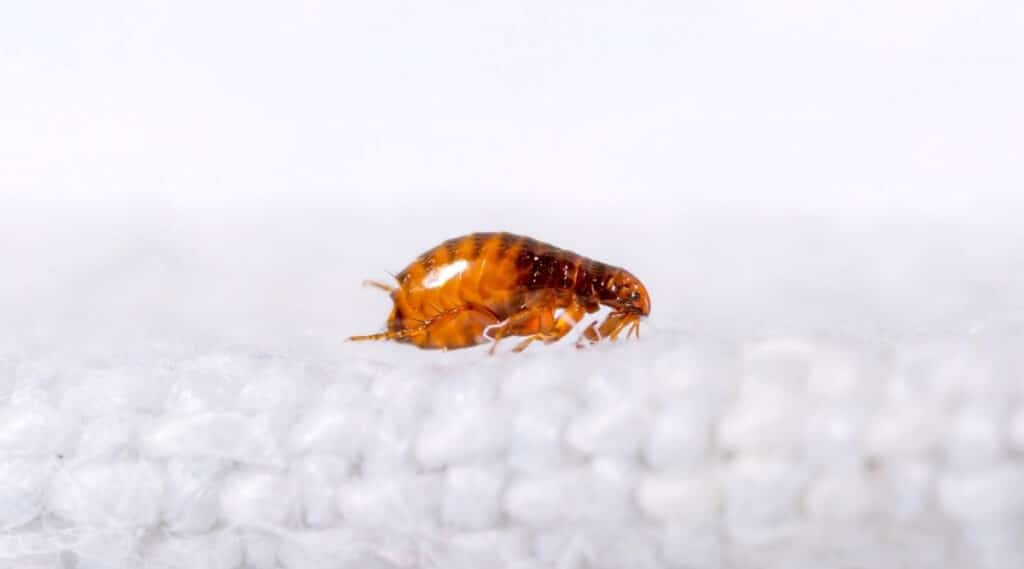
Now, it’s time to treat your carpet specifically. The first steps to take for a minor flea infestation are natural methods that will be gentler on your children and your pets. Here are a few natural ways you can begin the process of eradicating your carpeted areas of fleas.
Dish Soap Trap
For light infestations, this can help trap and remove fleas from carpet. Simply mix warm water and a bit of dish soap, such as Dawn, and leave it in the corner or near the edge of a room with suspected fleas.
Do this at night to take advantage of a fleas’ naturally nocturnal state. Fleas seek out water and jump in the dish. The soap traps the fleas and quickly kills them. Change the bowl every evening until you don’t have any fleas in the bowl for a few mornings in a row.
Natural Flea Sprays
You can make a flea spray to treat carpets using some natural ingredients. Mix four parts white vinegar to two parts water. Add a splash of witch hazel in about a ⅛ ratio.
You can use this spray alone or add flea fighting essential oils such as peppermint, cinnamon, rosemary, and cedarwood to the mix for further power. Spray this a few times a day on your carpet and at the thresholds to different rooms.
You can also spray it on furniture once you do a spot test to see if it affects the colorfastness of the fabric.
Diatomaceous earth
Spreading diatomaceous earth (DE) is safe for pets and children, but diatomaceous earth particles will deter fleas by quickly breaking down their exoskeleton. Combine DE with other methods above to help speed the process along.
Local gardening centers and nurseries will have diatomaceous earth since this is a frequently used product to protect gardens. You can also order it online and have it shipped straight to your home.
Vacuuming
Vacuuming goes a long way to ridding your home of fleas. Most insects cannot survive the gears of the vacuum, so running a vacuum over the floors several times a day can help remove fleas from carpet at all lifecycle stages.
Each time you vacuum, dump the canister, or change the bag and remove the trash from your home immediately. If anything manages to survive, it’ll be in the outside garbage can instead of in your home or vacuum cleaner.
Steam Cleaning
Renting a steam cleaner can be very helpful in getting rid of carpet fleas. The heat kills adult fleas and helps sanitize the area quickly and effectively. At the same time, the vacuum function removes other life cycle stages and any adult fleas left.
You might also consider hiring a professional company to steam clean your carpet and furniture to help ensure fleas don’t return. The heat from steam cleaning, especially professional equipment, is enough to kill both fleas and their eggs.
Heavy Duty Household Treatments
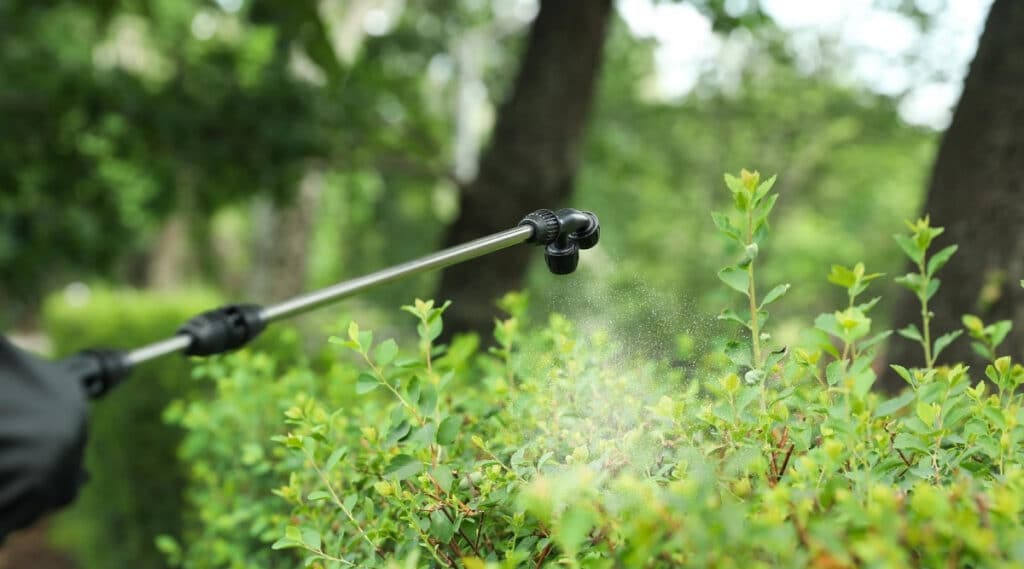
If natural methods aren’t working or you feel the infestation is too far gone for natural methods, there are a few more forceful options you can try.
Flea Foggers
Flea Foggers are like sprays, creating a fine mist that can settle into areas where you may not be able to reach. They use chemical insecticides to kill adult fleas and something called insect growth regulators (IGRs) to destroy fleas at other lifecycle stages.
Two types of chemicals work together to treat your carpet areas, but you’ll want to be very careful with these. Deep pile carpets may still hide fleas and their eggs, so you’ll still want to vacuum continually to help draw them out.
Chemical foggers are also a more dangerous option for pets and children. If you can close off rooms being treated for at least a week, this could help reduce the risk for you, your children, and your pets.
Flea Bombs
Bombs work the same way, but this method is not recommended unless you aren’t living in the home. These can cover the entire room in a fine layer of pesticides, but you won’t be able to be in the room for a while without the health risks.
If you’re treating a rental property and can leave the affected room empty for long enough to address the infestation and air out, this might be a good option for you.
Flea Sprays
Chemical flea sprays work by spreading insecticides and IGRs to specific areas but can be challenging to use in larger carpeted places. You must use them carefully and reach into the deep recesses of corners and closets for it to be effective.
Vacuum regularly and use caution if you have pets or children in your home. If you’re treating large areas, it’s best to work out a schedule for regular spraying to help get rid of fleas overall instead of chasing them all over your home.
Professional Help
Coordinating a professional exterminator helps you get rid of fleas once and for all. A professional can help you form a plan to ensure that fleas are gone from your carpet, your home, and even your property as much as possible.
Exterminators do use chemicals in some cases, but their expertise allows them to apply pest control to your home in ways that minimize risk to you while ensuring complete coverage. They’ll inspect your home for potential weaknesses for all pests and do follow-ups to ensure the problem is solved completely.
If fleas are a frequent issue or natural methods don’t seem to be making any headway in the problem, a professional might be your best option to protect your home. Don’t rule out this expert guidance as part of your long term pest control plan.
Getting Rid of Fleas in Your Carpet
Addressing fleas right away makes your home, including pets and kids, more comfortable. It also helps ensure that you’ve eliminated the root causes of fleas and prevents them from spreading disease throughout your home.
Whether natural methods are enough to handle your minor flea problem or a professional exterminator needs to come over, address the fleas you have right away. Your home and your sanity will thank you.
Share this post
Save time and money on pest control
Subscribe to expert DIY pest control tips, pest control product reviews and information.




